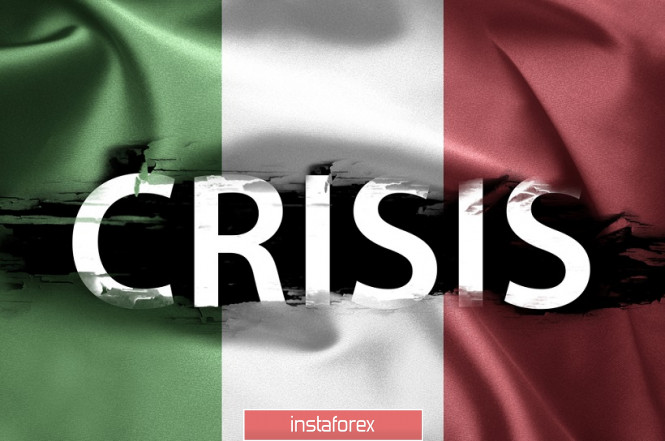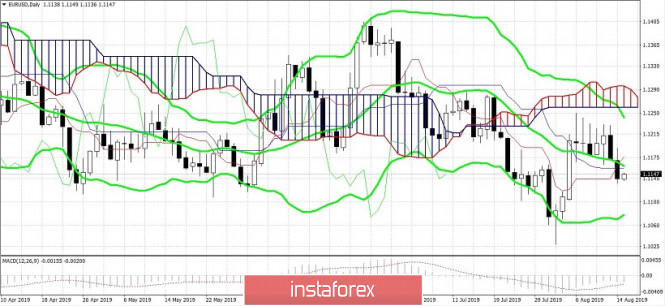The European currency remains under pressure. The euro has come under pressure not only from the political crisis in Italy but also from frustratingly weak macroeconomic reports. The negative fundamental picture pulls the EUR/USD pair down to the base of the 11th figure, even despite the uncertain positions of the American currency. However, the nearest significant support is slightly lower at around 1.1080, where the lower line of the Bollinger Bands indicator on the daily chart passes. EUR/USD bears are gradually approaching this target, although breaking the 1.1100 mark will be a daunting task for them.
It is worth noting that the EUR/USD pair holds within the 11th figure only due to the relatively weak dollar. Too many factors are pushing the single currency and the euro drives the downward movement. A block of macroeconomic statistics published this week greatly increased the likelihood of large-scale actions by the ECB to mitigate monetary policy. For example, the ZEW indices of Germany and the eurozone came out not only in the "red zone", but also updated multi-year lows. The German index crashed to -44 points while forecasting a decline to -27 points. The pan-European indicator showed similar dynamics, dropping to -43 points while forecasting a decline to -21 points. The indicator has fallen to its lowest levels since 2010, reflecting the pessimism of the European business environment.

Following the ZEW indices, the German economic growth indicator for the second quarter of this year was published. For the first time since the third quarter of 2018, German GDP fell into the negative region (-0.2%). After that, the market started talking about the risks of a technical recession in this country, which is the "locomotive" of the European economy. But it is worth noting here that representatives of the German government reacted quite calmly to this release (possibly because it coincided with the forecast values). Thus, a spokeswoman for the German government said that Berlin does not intend to request additional measures to stimulate the economy, as the country's GDP is predicted to grow in the second half of the year. This rhetoric calmed the markets, especially after the release of data on the growth of European GDP, showing that the indicator came out at the level of forecasts. This conveys a slight slowdown.
Nevertheless, the fact remains that the German economy contracted for the first time in almost 10 years, complementing the negative fundamental picture for the euro. In addition, the growth in the number of employed unexpectedly decreased in the EU countries, according to published data. After a three-quarter growth, the indicator suddenly came out worse than expected (0.2% versus 0.3% on a quarterly basis). The level of industrial production also decreased significantly by -1.6% in monthly terms and -2.6% in annual terms. This is the slowest indicator growth rate since December last year.
Today, many trading floors in Europe will be closed as the Catholic world celebrates the Assumption of the Blessed Virgin Mary. The European session is absolutely empty in the context of macroeconomic releases, hence, Italy will be the #1 topic for the traders of the pair. Let me remind you that the other day the Italian Senate did not support the proposal of the League, headed by Matteo Salvini, to vote on the issue of no confidence in the government. The largest political forces of the country opposed the initiative (except for the League, of course) but this does not mean that the political crisis is resolved. on the contrary, the situation has become even more complicated. Indeed, the de facto parliament in Italy is now lacking the ruling majority and in fact, the country's legislative body is blocked. This was due to disagreements between the League and the 5 Star Movement, the former coalition partners. The last straw in the conflict was the vote on the multi-billion dollar high-speed rail project between Italian Turin and French Lyon. This project was lobbied and supported by members of the League, while the 5 Stars voted against it in parliament. However, this issue only exacerbated the problem, while there were disagreements between political forces in other areas, particularly on the issue of decentralization and review of the minimum wage.
After the Senate vote, the situation came to a standstill. Against the backdrop of the absence of a coalition, the parliament did not allow the issue of a vote of no confidence in the government to be put to the vote. Now, a lot depends on the position of Italian Prime Minister Giuseppe Conte, who is due to speak on deputies at the Senate's residence on August 20. It is worth noting that if Salvini will be able to achieve re-elections, then most likely he will become the prime minister. According to recent polls, Liga can get about 35% in the elections. This fact may aggravate relations between Rome and Brussels, given Matteo's criticism of the central organs of the European Union.

Thus, the fundamental background for the euro remains negative. If the dollar positions strengthen in the near future, then the EUR/USD pair may test the 1.1100 mark. However, it is unlikely that the bears will gain a foothold in the area of the 10th figure, which requires more weighty arguments and a large-scale strengthening of the American currency.
The material has been provided by InstaForex Company - www.instaforex.com